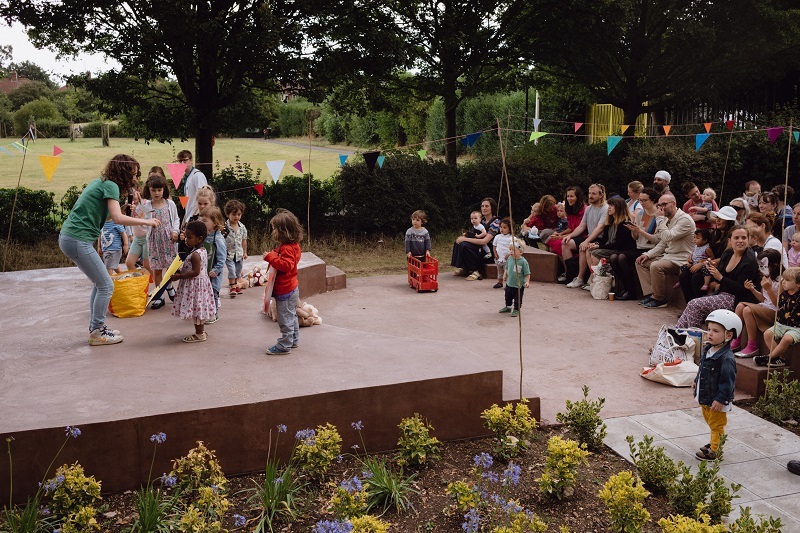Project showcase
Higham Hill Theatre, Waltham Forest - Create and London Borough of Waltham Forest with vPPR Architects

This project transformed a neglected plot of land behind a café and transformed it into a community amphitheatre surrounded by greenery at the edge of the community playground, adding life to the wider community. Its earthy tones represent its connections to the soil and the wider park.
Where is the project located - please enter full address and postcode?
Higham Hill Park, London E17 5PX
Who is the developer/client of the project?
LB Waltham Forest / Create
Describe the context of this project and how it has made a positive contribution to urban life or user experience of this place in 250 words max. and please upload an image of the project in its wider context or a drawing that best situates the project in its location.
The project is a small community amphitheatre in Higham Hill Park in Walthamstow, part of Waltham Forest‘s Making Places initiative. vPPR identified a neglected pocket of land located behind a café, surrounded by trees and on the edge of a community park and playground.
The design consists of a row of simple linear benches, facing a stage. A circular opening sits between the benches and the stage, doubling as a second stage. This circular space playfully disrupts the rectilinear geometry of the theatre, and introduces flexibility for both end stage and in the round configurations, catering for everyday informal play as well as formal performances. The theatre is compact– measuring 12m long by 6.5m wide, and only 400mm high – using minimal material to deliver maximum social value, accommodating approximately 75 people for sit down performances.
Constructed with pigmented concrete, its earthy-tone references the colour of the soil and strengthens its relationship to the surrounding park. The theatre benefits from the natural scenery of the park, enclosed with hedges at low level and a crown of trees above, with horizontal views beyond.
Importantly, the works extend beyond the theatre itself: significant new connections are made to the adjacent café, by introducing new double glass doors to a former solid brick wall; to a playground by inserting a gate where there was a fence before; and by introducing new landscaping including plants, hedges, paving and grass around the theatre itself.
What do you see as the greatest success of this project? 250 words max. Please attach an image of the project that supports your statement.
The greatest success of the project has been the creation of a stage for the local community where young people can be inspired to perform. The intimate size and natural setting of the theatre creates a friendly, unintimidating place for improvised play. Now connected to the adjacent playground, it has also become an extension of that play space, with activities ranging from groups of young children singing Christmas carols and dancing to their parents, toddlers playing kicking a ball around in the central circular stage, pre-schoolers scooting down the shallow ramp, or young school children leaping between the benches. On a more formal level, community dance groups, musicians and theatre groups have hosted workshops for the local community in the park, followed by performances on the stage.
By creating new connections to the theatre from the playground and the café, the space is welcoming from all directions and has transformed this neglected space into a destination. Becoming almost an extension of the cafe, the theatre provides additional external seating for the café and improves the quality of the internal space bringing lots of natural light inside, as well as drawing people outside to the theatre.
How does this public space bring people together, encourage inclusivity, and make a positive environmental impact to the wider place? 250 words max. Please attach an image of the project that supports your statement.
Located within a conservation area the site is surrounded by a variety of This space brings people together every day by offering anyone a place to sit and play. Community members are invited to hold events there – even yoga or baby groups. The launch event included performances by a local street dance community group, drumming group and children’s entertainer, as well as mask-making activities for children. Since then, the theatre is informally in constant use by children rehearsing on the stage, people eating lunch, children playing there. The project has succeeded to engage and inspire the local community to get involved in theatre and creative arts. The social benefits are enormous, facilitating theatre for the community and reducing anti-social behaviour. Environmentally the robust design of the project activates this neglected corner of the park, and re-landscapes around the theatre, promoting biodiversity.
Please share any data or figures that support your entry about how this public space or landscape intervention has made a positive social, economic or environmental impact, for example biodiversity, increased dwell time, flood or drainage mitigation, wellness or safety. You may also attach an additional image or document to support your entry.
Previously the main use of this space was for anti-social behaviour. The space is now constantly in use by all ages. A laurel hedge and other planting is now maturing creating natural edges to the theatre. Increased demand at the cafe is complemented by this expanse of new seating.
Festival of Pineapples
24-26 February 2026
Pineapples prize giving night
April
Pineapples at Festival of Place
10 June 2026
© The Pineapples - Tweak Ltd. 124 City Road, London, EC1V 2NX. Tel: 020 3326 7238




